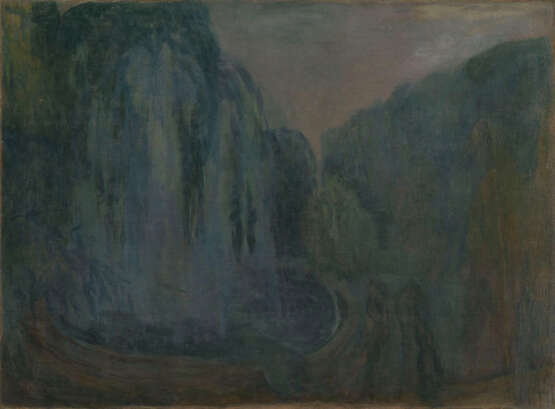ID 70686
Lot 21* | KUZNETSOV, PAVEL (1878-1968) Fountain , signed and dated 1904.
Estimate value
£ 250 000 – 500 000
Provenance: Important private collection, Europe.
Authenticity of the work has been confirmed by the expert I. Geraschenko.
Authenticity certificate from the expert I. Gofman.
Related literature: For similar works, see L. Budkova, D. Sarabianov, Pavel Kuznetsov, Moscow, Sovetskii khudozhnik, 1975, pls. 6 and 8, illustrated; p. 320, Nos. 85 and 89, listed; p. 322, No. 96, listed.
The appearance of Pavel Kuznetsov’s Fountain at the forthcoming auction is a notable event. The symbolist “fountains” make up an extremely important stage in Kuznetsov’s creative biography, a stage that largely determined the future development of Silver Age in Russian art and of symbolism in particular. The subject appeared in his canvases, becoming a favourite theme, between 1904 and 1907, even before the famous Blue Rose exhibition that formally inaugurated the legendary association. Kuznetsov is thought to have been inspired by the real fountains that he saw in his teenage years in his home town of Saratov on the Volga. In the future painter’s memory, this artificial, ornamental source remained as an indelible recollection of the life-giving moisture and freshness that water the natural world, and it symbolised the flow of radiant, fantastic dreams. However, the image of Kuznetsov’s fountains is amazingly attuned to the poetic and musical quests of his time and comes to be a kind of symbol of aesthetic world-weariness and decadent, transcendental and romantic yearning and expectation.
In his “fountains”, Kuznetsov showed himself to be a direct heir to Viktor Borisov-Musatov, who died early in life. But his compositions, so full of unaccountable sadness and meditative poetic sentiment, amount to a development on a different level. For instance, the work now offered tends towards harmony, which the artist sees as something intrinsic and mandatory for a coherent artistic image. His twilight, silver-shimmering colour scheme ushers the viewer into a dreamy ecstasy. By expressing abstract, universal ideas, the artist aspires to an amalgamation of thought and emotion. This elusive indefinability of content, its irreducibility to words and concepts, which presupposes the presence of something immaterial and something else, “superterrestrial”, led to the emergence of a special language of colour and form in painting. Light lost its substance, and objects seemed to start emitting light themselves. As a result, the pictorial plane, which is perfectly “woven” like a tapestry, forms a kind of curtain, a veil over the distance that shows through behind it. The paint and even the very soil seem to be saturated with light, and this brings Kuznetsov’s painting closer to fresco art. The blurred outlines of the figures in “Fountain”, the ethereal, hazy contours of the drooping trees, just slightly wrapped in a covering of autumnal yellow, the mist, the fluidity and the half-wakeful, half-dreamy state of what is happening, come close, as if hiding the secret source of the awakening of life, to the cycle of the universe of the “mysterious fountain” described by Osip Mandelstam, who clothes his soul in a moist “robe of thought”.
The showing of Fountain at the auction is also important because a 1911 fire that occurred at The Black Swan, Nikolai Ryabushinsky’s villa just outside Moscow, destroyed many canvases painted by members of the Blue Rose association and owned by the patron and collector. Pavel Kuznetsov’s works were the main ones to suffer, since he had been given the principal role in decorating the interior of the mansion. This disaster, which occurred when the symbolist stage in the artist’s work had almost ended, cast over Kuznetsov’s works of the 1900s the veil of a lost dream, which so befitted them, and, to use Abram Efros’s figurative expression, closed “unearthly doors” into the world where Pavel Kuznetsov “extolled the cascades of his fountains”.
| Address of auction |
MacDougall Arts Ltd. 63 New Cavendish St. W1G 7LP London United Kingdom | |
|---|---|---|
| Preview |
| |
| Phone | +44 20 7389 8160 | |
| Phone | +7 495 799 4683 | |
| Fax | +44 (0) 20 7389 8170 | |
| Conditions of purchase | Conditions of purchase | |
| Shipping |
Postal service Courier service pickup by yourself | |
| Payment methods |
Wire Transfer |




